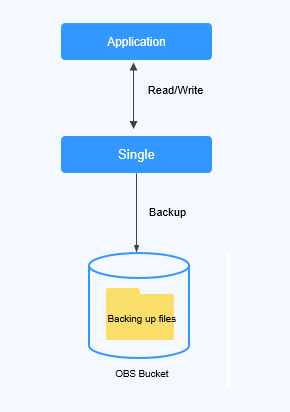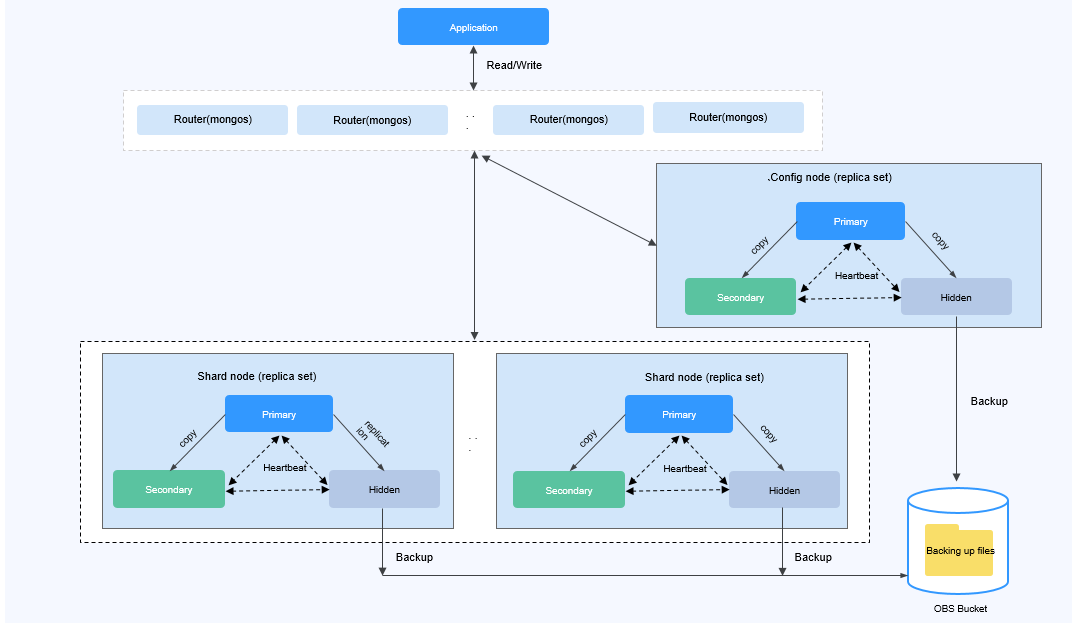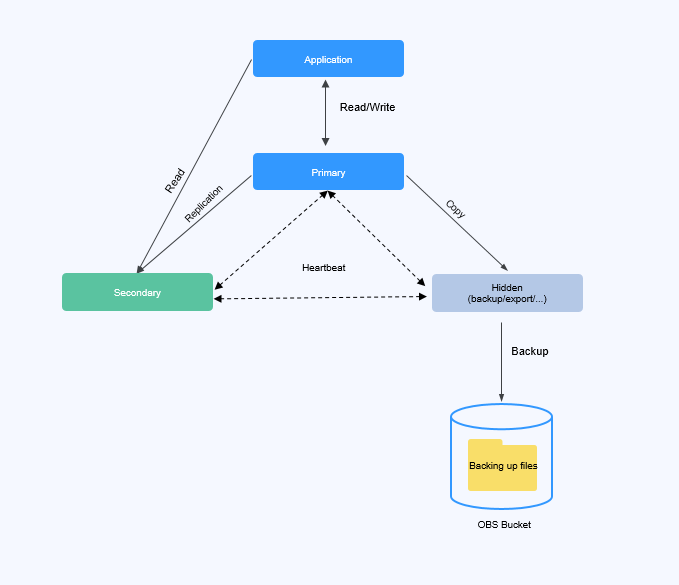Princípios e soluções de backup
As instâncias do DDS suportam backups automáticos e manuais. Você pode periodicamente fazer backup de bancos de dados. Se um banco de dados estiver com defeito ou os dados estiverem danificados, você poderá restaurar o banco de dados usando arquivos de backup para garantir a confiabilidade dos dados.
Princípios de backup
- Instância do cluster
Uma instância de cluster consiste em um nó config e vários nós dds mongos e shard. O nó config é usado para armazenar as informações de configuração de uma instância de cluster e o nó shard é usado para armazenar dados de uma instância de cluster. Fazer backup de uma instância de cluster significa que os dados nos nós config e shard são copiados separadamente. Conforme mostrado em Figura 1, os nós config e shard em uma instância de cluster são copiados em seus próprios nós ocultos. O processo de backup ocupa certos recursos de CPU e memória dos nós ocultos. Durante o backup, o uso da CPU, o uso da memória e o atraso primário/em espera do nó oculto aumentam ligeiramente, o que é normal. Os arquivos de backup nos nós ocultos serão então compactados e armazenados no OBS, e o espaço de armazenamento da instância não será ocupado.
- Instância do conjunto de réplicas
Como mostrado em Figura 2, os dados da instância do conjunto de réplicas são copiados em nós ocultos. O processo de backup ocupa certos recursos de CPU e memória do nó oculto. Durante o backup, o uso da CPU, o uso da memória e o atraso primário/em espera do nó oculto aumentam ligeiramente, o que é normal. Os arquivos de backup nos nós ocultos serão então compactados e armazenados no OBS, e o espaço de armazenamento da instância não será ocupado.
- Instância de nó único:
O backup de instância de nó único é realizado em apenas um nó. O arquivo de backup é armazenado no OBS como um pacote, que não ocupa o armazenamento da instância.

O backup de uma instância de nó único é feito usando o mongodump. Durante o backup, os recursos de CPU e memória do nó são ocupados. Se os recursos forem insuficientes, o backup falhará. Recomendamos que você migre os dados da instância de nó único para uma instância do conjunto de réplicas para backup.
Figura 3 Princípio do backup de instância de nó único
Solução de backup e restauração
- Tabela 1 descreve como fazer backup e baixar arquivos de backup.

Por padrão, todas as versões do DDS 3.2, 3.4, 4.0, 4.2 e 4.4 são suportadas, a menos que especificado de outra forma.
Tabela 1 Soluções de backup Tipo da tarefa
Método
Tipo e versão da instância
Cenário
Fazer backup de dados
- Cluster
- Conjunto de réplicas
- Nó único
Você pode executar backup automático para instâncias do DDS no console de gerenciamento.
- Cluster (versões 4.0 e 4.2)
- Conjunto de réplicas (versões 4.0 e 4.2)
Você pode realizar backup incremental para instâncias do DDS no console de gerenciamento.
- Cluster
- Conjunto de réplicas
- Nó único
Você pode executar o backup entre regiões no console do DDS.
- Cluster
- Conjunto de réplicas
- Nó único
Você pode executar backup manual para instâncias do DDS no console de gerenciamento.
- Cluster
- Conjunto de réplicas
- Nó único
Você pode usar a ferramenta de backup e restauração fornecida pelo cliente MongoDB para fazer backup do seu banco de dados MongoDB criado por você mesmo ou do banco de dados MongoDB na nuvem.
- Cluster
- Conjunto de réplicas
- Nó único
Você pode usar a ferramenta de backup e restauração fornecida pelo cliente MongoDB para fazer backup do seu banco de dados MongoDB criado por você mesmo ou do banco de dados MongoDB na nuvem.
Download de um arquivo de backup
- Cluster
- Conjunto de réplicas
- Nó único
Se o tamanho de um arquivo de backup for maior que 400 MB, use o OBS Browser+ para baixar o arquivo.
- Conjunto de réplicas
- Nó único
Você pode baixar diretamente arquivos de backup usando um navegador.
- Cluster
- Conjunto de réplicas
- Nó único
Você pode baixar os arquivos de backup em uma nova janela do navegador ou usando o Xunlei ou o Wget.
- Para obter detalhes sobre o esquema de restauração do DDS, consulte Soluções.
Cobrança
Os backups são salvos como pacotes em buckets do OBS. Os backups ocupam espaço de backup no OBS. Se o espaço livre fornecido pelo DDS for usado, o espaço adicional necessário será cobrado. Para obter detalhes de cobrança, consulte Como os dados de backup do DDS são cobrados?








